This article was medically reviewed by Lacy Windham, MD. Lacy Windham, MD, is a Board-Certified Obstetrician & Gynecologist in Cleveland, Tennessee. Dr. Windham attended medical school at the University of Tennessee Health Science Center in Memphis. Her residency was completed at Eastern Virginia Medical School in Norfolk, Virginia. She was the recipient of multiple awards during her residency training, including Most Outstanding Resident in Maternal Fetal Medicine, Most Outstanding Resident in Oncology, Most Outstanding Resident Overall, and Special Award in Minimally Invasive Surgery.
There are 10 references cited in this article, which can be found at the bottom of the page.
This article has been viewed 412,170 times.
Experts agree that lumps in your breasts are often benign, so try not to worry if you feel a lump. It's normal to be concerned, so you likely want to get a lump checked out immediately.[1] Research suggests that lumps are more likely to be serious if you also have changes to your breast, like dimpled skin, unusual nipple discharge, or your nipple turning inward.[2] If you think you might have a lump, talk to your doctor so you can get treatment right away if you need it.
Steps
Self-Identifying Breast Lumps and Abnormalities
-
1Perform monthly self-breast exams to identify a lump in a breast. Most lumps are found by women, often by accident (in fact, 40% of breast cancers are found by women self-reporting a lump in their breast to their doctor). [3]
- Start by standing in front of a mirror to look at your breasts, with your hands on your hips (as this optimizes the positioning of your breasts so that you can look at them and compare them). [4] Things to look for include: breasts that are similar to their normal in terms of size, shape, and color; no swelling; no skin changes; no nipple discharge or nipple changes; and no redness or soreness.
- The next step in your breast self-exam is to raise your arms above your head, and to examine your breasts for the same features listed above. [5] This change in position of your arms alters how your breasts sit, and is another way to identify any changes.
- The next part of the breast self-exam is done lying down. [6] Lift your right arm over your head. With your left hand, apply firm pressure to your right breast. Move your fingers in a circular motion around the nipple, the surrounding tissue and the armpit. [7] Be sure to cover the full surface area of the breast, from the collarbone to the bottom of the rib cage, and from the armpit to the breastbone. Raise your left arm and repeat the process examining your left breast, surrounding tissue and the armpit with your right hand.
- Doing a breast exam in the shower also works. [8] You may actually be better at reading your breast when your fingers are wet and soapy as your fingers will glide over your breast tissue more easily.
-
2Talk with your doctor if you feel new lumps (most are pea-sized) or firm and hard breast tissue. If you do find one, don't fret; odds are it's not cancerous — eight out of 10 aren't. [9] The benign ones are usually caused by cysts, a fibroadenoma, or just generalized breast lumpiness.
- It's not unusual to develop breast lumps for a short duration of time; most often, these are related to the menstrual cycle (they are called "physiological breast lumps" and come and go each month in sync with your menstrual cycle).
- In order to distinguish "physiological breast lumps" (related to your period) from worrisome ones, watch to see whether the lump grows and then shrinks again within the month, and whether this pattern repeats monthly with your cycle. If this is not the case, or if the lump continues to grow, it is always best to seek the advice of your physician.
- The best time to do breast self-examination is one week before your period starts (as this is the time when it is least likely, hormonally, to have lumps related to your period). If you are post-menopausal or have irregular periods, you can examine your breasts on the same day of each month to keep your self-examination process as consistent as possible.
Advertisement -
3Pay close attention to breast lumps that suddenly grow or change in shape. Most women have inconsistencies in breast tissue (it is the nature of how our breasts are), but if this changes over time (or grows) it is more likely to be worrisome. Also, you can assess one breast in comparison to the other — if both breasts feel the same, it is not a worry, but if one breast has a lump that is definitely not present in the other, this is more of a cause for concern. [10]
-
4Be aware of other concerning symptoms. These symptoms may or may not occur in conjunction with a breast lump; if they do, the lump is more likely to be worrisome and it is best to see a physician sooner rather than later. [11]
- Look for a bloody or pus-like nipple discharge.
- Watch for a red or pink rash near or around the nipple.
- Notice any changes in your nipple, especially if it becomes inverted.
- Observe breast skin. If it becomes thick, scaly, dry, dimpled, red or pink, talk to your doctor.
Seeking Help and Medical Evaluation From Your Physician
-
1Call your family doctor if you are unsure whether your breast lump is of concern. It is always best to have reassurance that things are fine, or the proper series of investigations and tests as soon as possible if your doctor agrees that there is cause for concern.
- Medical professionals are well-trained in how to evaluate and assess breast lumps, and in particular in how to rule out breast cancer. [12] If in doubt, do not hesitate to ask for doctors advice.
- Breast cancer is a realistic concern for many women (being the number one most frequent cancer diagnosis in women). [13] One in nine women are diagnosed with breast cancer in their life, so if in doubt get your breast lump checked out by a doctor sooner rather than later. Most breast lumps are benign (not worrisome), and many cancer diagnoses are completely treatable if caught sooner rather than later.
- Keep in mind, however, that breast cancer under the age of 20 is very rare, and it is very uncommon under the age of 30.
-
2Set up a mammography appointment. Do this on an annual basis or as prescribed by your doctor. This is a low-dose X-ray examination used for locating breast tissue abnormalities.
- Mammograms are the number one way in which breast cancers are caught and diagnosed. [14] It can be used as a screening test (routine test for any woman over the age of 40 to rule out breast cancer even without symptoms or lumps), and also as a diagnostic test (for women with a breast lump to gather further information to determine whether or not the lump is of concern).
- For a young patient with dense breast tissue, however, an MRI may be a better test than mammogram.
- People who receive a mammogram for diagnostic reasons (to determine whether or not their breast lump is worrisome) will likely also receive additional tests to add to the information your doctor has to work with, to determine whether or not she is concerned about your breast lump.
-
3Proceed with a breast ultrasound for further investigation of your lump if your physician recommends this. [15] Ultrasound provides a different viewpoint of the breast than mammography, and can help to differentiate between solid and cystic masses (cystic masses are generally fluid-filled and not of concern; in other words, not cancerous).
- An ultrasound can also provide further information to see whether a biopsy (sample of the breast tissue taken with a needle and examined by doctors under the microscope) is needed. [16]
-
4Have your physician prescribe a breast lump biopsy if the other test results are unable to rule out breast cancer. [17] A sample of your breast tissue will be examined under a microscope, which can give a definite answer as to whether the lump is benign (non-worrisome) or malignant (cancerous).
- If the lump is in fact diagnosed as breast cancer, you will be referred to an oncologist (cancer specialist) and perhaps a surgeon for surgical, hormonal, or chemotherapy treatments, depending upon the severity.
- Again, it is important to be aware that the great majority of breast lumps are not cancer; [18] however, it is always best to see your physician and to have the recommended tests done in order to rule out any possibility, and to get treatment as soon as possible (which results in the most successful outcomes) if you are in fact diagnosed with breast cancer.
- At times, a breast MRI or ductogram will be used as "diagnostic tests" by your doctor, but these are significantly less common than mammograms, ultrasounds, and breast biopsies. [19]
-
5Follow-up as per your doctor's advice. [20] Oftentimes, if a breast lump is determined to be not particularly concerning, your doctor will ask that you continue to monitor it over time and to report back if there are any significant changes or growth. Most often there will not be, but it is always better to be safe rather than sorry and to continue paying attention to any lumps or different textures to your breast to see if these change or worsen with time (at which point a follow-up visit to your family doctor is recommended).
Expert Q&A
Did you know you can get expert answers for this article?
Unlock expert answers by supporting wikiHow
-
QuestionI just gave birth 3 months ago and once I was feeding my baby when I felt a big lump in my right breast, underneath the breast and on the side. What could it be?
 Lacy Windham, MDLacy Windham, MD, is a Board-Certified Obstetrician & Gynecologist in Cleveland, Tennessee. Dr. Windham attended medical school at the University of Tennessee Health Science Center in Memphis. Her residency was completed at Eastern Virginia Medical School in Norfolk, Virginia. She was the recipient of multiple awards during her residency training, including Most Outstanding Resident in Maternal Fetal Medicine, Most Outstanding Resident in Oncology, Most Outstanding Resident Overall, and Special Award in Minimally Invasive Surgery.
Lacy Windham, MDLacy Windham, MD, is a Board-Certified Obstetrician & Gynecologist in Cleveland, Tennessee. Dr. Windham attended medical school at the University of Tennessee Health Science Center in Memphis. Her residency was completed at Eastern Virginia Medical School in Norfolk, Virginia. She was the recipient of multiple awards during her residency training, including Most Outstanding Resident in Maternal Fetal Medicine, Most Outstanding Resident in Oncology, Most Outstanding Resident Overall, and Special Award in Minimally Invasive Surgery.
Board Certified Obstetrician & Gynecologist
-
QuestionIs it normal to have a small ball in my breast?
 Lacy Windham, MDLacy Windham, MD, is a Board-Certified Obstetrician & Gynecologist in Cleveland, Tennessee. Dr. Windham attended medical school at the University of Tennessee Health Science Center in Memphis. Her residency was completed at Eastern Virginia Medical School in Norfolk, Virginia. She was the recipient of multiple awards during her residency training, including Most Outstanding Resident in Maternal Fetal Medicine, Most Outstanding Resident in Oncology, Most Outstanding Resident Overall, and Special Award in Minimally Invasive Surgery.
Lacy Windham, MDLacy Windham, MD, is a Board-Certified Obstetrician & Gynecologist in Cleveland, Tennessee. Dr. Windham attended medical school at the University of Tennessee Health Science Center in Memphis. Her residency was completed at Eastern Virginia Medical School in Norfolk, Virginia. She was the recipient of multiple awards during her residency training, including Most Outstanding Resident in Maternal Fetal Medicine, Most Outstanding Resident in Oncology, Most Outstanding Resident Overall, and Special Award in Minimally Invasive Surgery.
Board Certified Obstetrician & Gynecologist
-
QuestionWhat if I have a dense breast shown on mammograms and I feel a lump and soreness in my right armpit?
 Lacy Windham, MDLacy Windham, MD, is a Board-Certified Obstetrician & Gynecologist in Cleveland, Tennessee. Dr. Windham attended medical school at the University of Tennessee Health Science Center in Memphis. Her residency was completed at Eastern Virginia Medical School in Norfolk, Virginia. She was the recipient of multiple awards during her residency training, including Most Outstanding Resident in Maternal Fetal Medicine, Most Outstanding Resident in Oncology, Most Outstanding Resident Overall, and Special Award in Minimally Invasive Surgery.
Lacy Windham, MDLacy Windham, MD, is a Board-Certified Obstetrician & Gynecologist in Cleveland, Tennessee. Dr. Windham attended medical school at the University of Tennessee Health Science Center in Memphis. Her residency was completed at Eastern Virginia Medical School in Norfolk, Virginia. She was the recipient of multiple awards during her residency training, including Most Outstanding Resident in Maternal Fetal Medicine, Most Outstanding Resident in Oncology, Most Outstanding Resident Overall, and Special Award in Minimally Invasive Surgery.
Board Certified Obstetrician & Gynecologist
Warnings
- One in nine women are diagnosed with breast cancer in their lifetime, so it is a real concern and definitely not something to ignore if you are worried about a breast lump you have. At the same time, breast self-exams actually a bit controversial. There is evidence that in low-risk populations, it mostly increases patient anxiety and increases the rate of biopsies for non cancers.⧼thumbs_response⧽
References
- ↑ https://www.mayoclinic.org/healthy-lifestyle/womens-health/in-depth/breast-lump/art-20044839
- ↑ https://www.nhs.uk/conditions/breast-lump/
- ↑ http://www.nationalbreastcancer.org/breast-self-exam
- ↑ http://www.breastcancer.org/symptoms/testing/types/self_exam/bse_steps
- ↑ http://www.breastcancer.org/symptoms/testing/types/self_exam/bse_steps
- ↑ http://www.breastcancer.org/symptoms/testing/types/self_exam/bse_steps
- ↑ http://www.nationalbreastcancer.org/breast-self-exam
- ↑ http://www.nationalbreastcancer.org/breast-self-exam
- ↑ http://www.nationalbreastcancer.org/breast-self-exam
- ↑ http://emedicine.medscape.com/article/1947145-overview
- ↑ http://emedicine.medscape.com/article/781116-overview
- ↑ http://www.uptodate.com/contents/clinical-manifestations-and-diagnosis-of-a-palpable-breast-mass
- ↑ http://www.uptodate.com/contents/diagnostic-evaluation-of-women-with-suspected-breast-cancer
- ↑ http://www.uptodate.com/contents/diagnostic-evaluation-of-women-with-suspected-breast-cancer
- ↑ http://www.uptodate.com/contents/diagnostic-evaluation-of-women-with-suspected-breast-cancer
- ↑ http://www.uptodate.com/contents/diagnostic-evaluation-of-women-with-suspected-breast-cancer
- ↑ http://www.uptodate.com/contents/diagnostic-evaluation-of-women-with-suspected-breast-cancer
- ↑ http://www.medscape.com/viewarticle/443381_3
- ↑ http://www.mayoclinic.org/healthy-lifestyle/womens-health/in-depth/breast-lump/art-20044839?pg=2
- ↑ http://www.mayoclinic.org/healthy-lifestyle/womens-health/in-depth/breast-lump/art-20044839?pg=2
About This Article
To identify a lump in your breast, stand in front a mirror with your hands on your hips. First, look for any abnormalities in your breasts, like swelling, redness, or discharge. Then, raise your arms above your head, which will give you a better view of your breasts’ underside, and check again. After you’ve checked in a mirror, lie on your bed with your right arm over your head. Use your left hand to apply pressure to your right breast in small circles. Feel the nipple, breast, and armpit for any lumps. Swap arms and repeat the process. Don’t worry too much if you do find a lump, since 8 out of 10 aren’t cancerous and will go away on their own. However, you should visit your doctor to get it checked out just in case. Try to examine your breasts every month for lumps. For more tips from our Medical co-author, including how to get a breast tissue X-ray, read on.


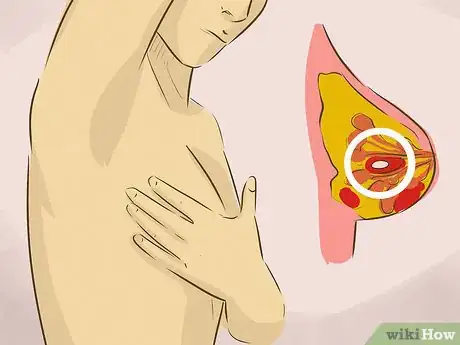

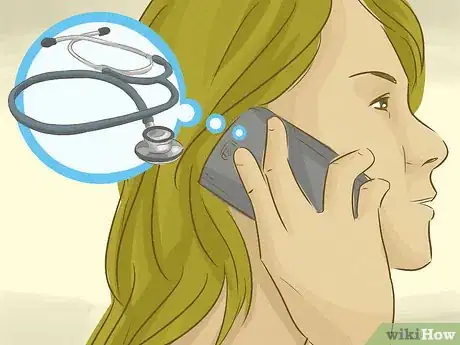
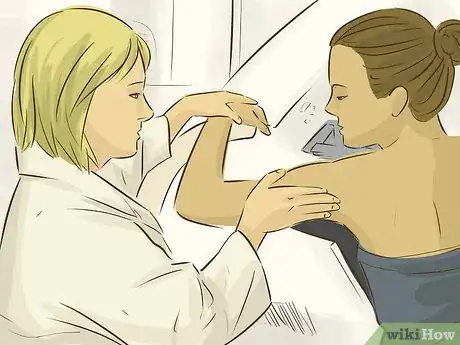
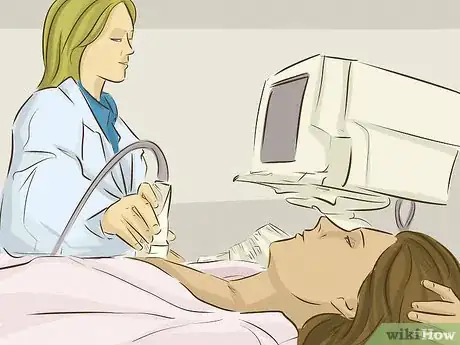
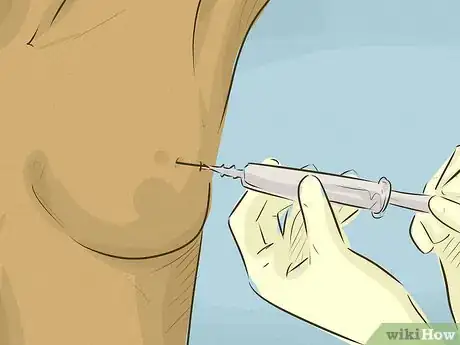
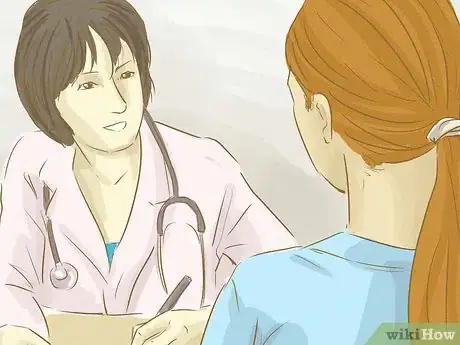
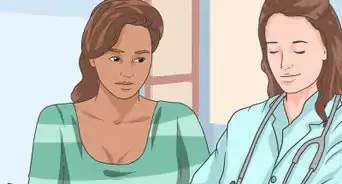
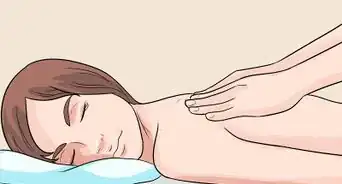


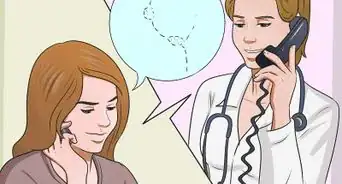

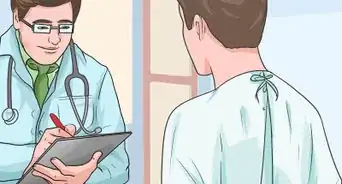
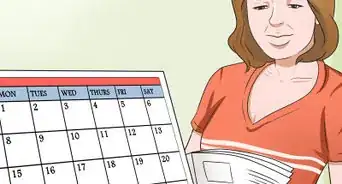
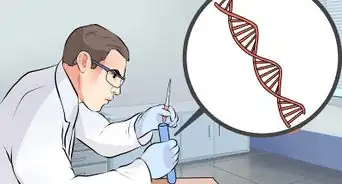
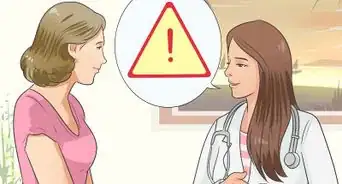
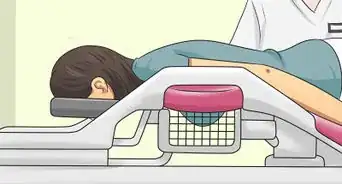










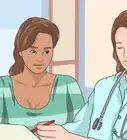






































Medical Disclaimer
The content of this article is not intended to be a substitute for professional medical advice, examination, diagnosis, or treatment. You should always contact your doctor or other qualified healthcare professional before starting, changing, or stopping any kind of health treatment.
Read More...